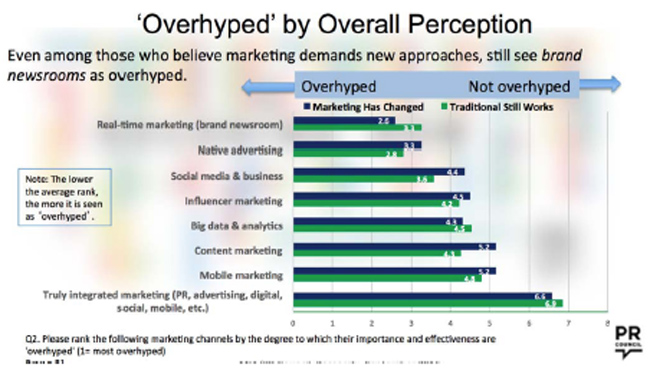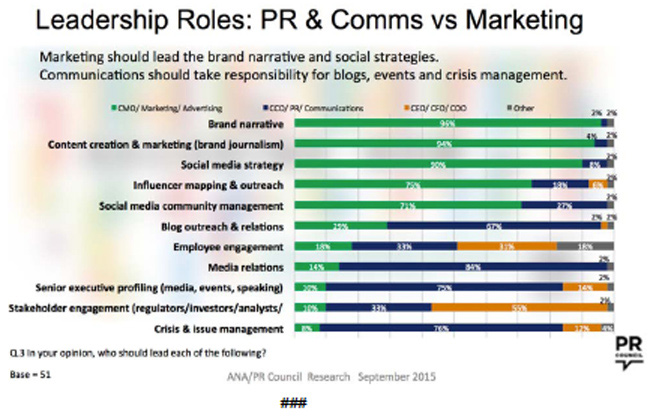Maybe the constant kibitzing throughout PR and communications precincts about “real-time marketing” is just a bunch of lips flapping in the breeze.
So-called “real-time marketing” (such as “brand newsrooms”) ranked as the most overhyped marketing initiative, according to a new survey conducted by the PR Council.
The survey, which was released Thursday during the PR Council’s Critical Issues Forum, took the pulse of 56 senior marketing executives who represent major U.S. corporate members of the Association of National Advertisers. It found a significant gap between rhetoric and reality when it comes to developing and distributing real-time marketing programming.
About half of the respondents (49 percent) ranked brand newsrooms as either the number one or number two most overhyped marketing approach. Native advertising and social media followed suit as overhyped. Only 4 percent ranked real-time brand newsrooms as a top priority, and none ranked native advertising as the top priority.
But they did not dismiss content marketing entirely. It came in a distant second in terms of strategic priorities with 27 percent naming it a top priority while 13 percent ranked it No. 2.
Kathy Cripps, president of the PR Council, said in a news release that the problem for both media newsrooms and corporate brand newsrooms is “maintaining a high-volume stream of relevant content over a long time.”
Indeed, lack of stick-to-itiveness, as well as budgetary issues and skepticism from the C-suite about the ROI on real-time marketing are major impediments to developing real-time marketing programming.
Another part of the problem: PR and marketing executives continue to jockey for position regarding whom should lead which areas of media and marketing expertise.
Marketers, apparently, continue to take a fairly dim view of PR.
“The marketers answering this survey left no doubt as to their view that they should own most [disciplines] and said public relations should only lead media and blogger relations, crisis management, and building executives’ public profiles,” the study said. “They felt advertising and marketing should lead on brand narrative, content, social media strategy and influencer marketing.”
Influencer marketing, which is still in just the top of the second inning, is also sparking a schism between PR and marketing and advertising executives.
Brian Solis, principal analyst at the Altimeter Group and author of X: Where Experience Meets Design, said in the PR Council’s a release that advertisers and public relations professionals interpret the very notion of influencer marketing differently.
“This is the key difference between advertising and public relations,” he said. “Advertising will find a few top celebs, with some of them being Internet famous, to become part of a campaigns. PR on the other hand, will find said influencers and nurture longer- term relationships that keep the brand relevant now and in the long term.”


 Abandon traditional content plans focused on a linear buyer progression and instead embrace a consumer journey where no matter which direction they travel, they get what they need, stressed marketing pro Ashley Faus during O'Dwyer's webinar Apr. 2.
Abandon traditional content plans focused on a linear buyer progression and instead embrace a consumer journey where no matter which direction they travel, they get what they need, stressed marketing pro Ashley Faus during O'Dwyer's webinar Apr. 2. Freelance marketers and the companies that hire them are both satisfied with the current work arrangements they have and anticipate the volume of freelance opportunities to increase in the future, according to new data on the growing freelance marketing economy.
Freelance marketers and the companies that hire them are both satisfied with the current work arrangements they have and anticipate the volume of freelance opportunities to increase in the future, according to new data on the growing freelance marketing economy. Home Depot's new attempt to occupy two market positions at once will require careful positioning strategy and execution to make it work.
Home Depot's new attempt to occupy two market positions at once will require careful positioning strategy and execution to make it work. Verizon snags Peloton Interactive chief marketing officer Leslie Berland as its new CMO, effective Jan. 9. Berland succeeds Diego Scotti, who left Verizon earlier this year.
Verizon snags Peloton Interactive chief marketing officer Leslie Berland as its new CMO, effective Jan. 9. Berland succeeds Diego Scotti, who left Verizon earlier this year.  Norm de Greve, who has been CMO at CVS Health since 2015, is taking the top marketing job at General Motors, effective July 31.
Norm de Greve, who has been CMO at CVS Health since 2015, is taking the top marketing job at General Motors, effective July 31.


 Have a comment? Send it to
Have a comment? Send it to 
No comments have been submitted for this story yet.